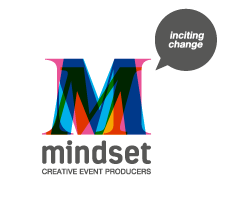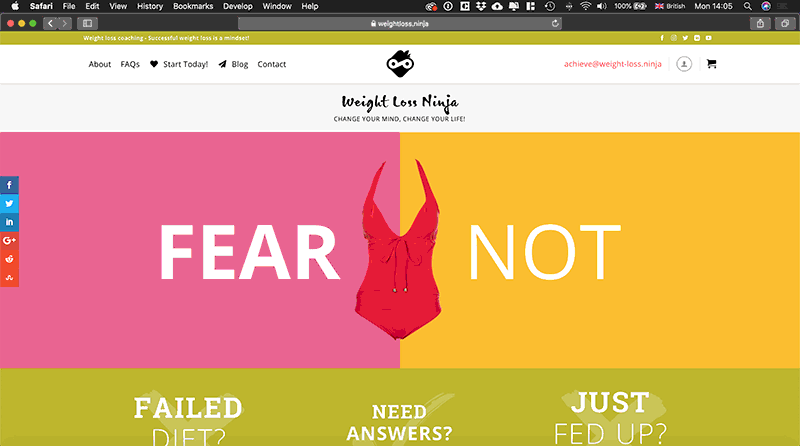The secret to creating an online learning course is to know what you want in the first place.
You may have been thinking that I was about to say something about getting in a professional video crew, or to put everything into a well-planned script, or going out and buying good sound equipment…….well, all those things are important as well, however probably the biggest thing I could say is to make sure you know that you want to create an online course in the first place.
As with all new ventures nothing comes to fruition without putting the effort in and, in the case of our latest online course, The Weight Loss Ninja, it was 6 months of work from start to finish with many, many moments during its production when I personally wondered if it was still a good idea to push ahead with it or not. The thing that kept me going was being connected to my original goal……..I really wanted to do more and more online courses.
It’s all about being connected with your goals

Being really connected with my initial goal, why I wanted it, and by being really focussed on bringing it to life, this all meant that I pushed through all the obstacles I encountered along the way:
- over 100 videos scripted, filmed and edited
- nearly 90 days of editing
- 19 days of scriptwriting
- 4 days of planning on paper
- numerous internal meetings
- many tens of thousands of pounds spent
- multiple late nights in the edit suite
- a website built from the ground up
- an entire marketing campaign created including 16 marketing videos
- new social channels set up
- legal and insurance expenses
- compliance
- ……the list goes on
…and if you’re planning yourself to set up your own online learning business then the purpose of this blog is definitely not to put you off with this list above. Quite the opposite in fact.
Start small and get some quick wins in nice and early
As well as being a coach and a live events producer, I’m also the owner of a video production business with all the lights, cameras, sound, crew etc. all in-house. So, for me, doing this latest online course properly was always going to be the only way I was going to approach it. However it all could so easily still have been created with a smart phone and a microphone.
The reason why we invested so much time in it was because we wanted the customer experience to be as enjoyable and productive as we could have made it, but if you don’t have access to all these facilities, then grab a camera, invest £50 in a decent plug-in microphone and essentially you’re pretty much ready to get started.
But it still comes back to my original point. First and foremost, know what it is that you want.
That all said, it’s still essential to know that you want to create an online course in the first place. Realistically it could well turn into a solid month of work at the very least. And here below is the order in which we would recommend you could approach the production:
- Work out why you want to become a producer of online learning programmes. What will it give you when you’re successful?
- Now do a reality check. Being human means that often we’re optimistic and overconfident about how easy things will be. Realistically a good online course will take between 1 and 2 months to create from start to finish. Do you have that time to invest?
- Decide upon what topic you want to create. We’re all good at something. My recommendation would be to write down all the things that you are good at and that you’re passionate about, including topics that you can talk about with some level of authority.
- Next up, try and turn the volume down of that inner voice that will quite possibly now be talking to you telling you that you’re not expert enough in this field to talk about it. It’s very natural to feel like this. Try and not let that voice kill off any enthusiasm you have for your new venture. Nothing comes out of inactivity and sometimes our inner voice can, at times, be our own worst enemy.
- Plan, plan and plan. Start at the beginning and lay out a rough structure. I personally used mind maps here to get all the subjects down on my iPad and then I organised them into rough categories (which I then formed into the 6 sections of the course). Then I ordered each video within each section so that the overall message had a nice, logical flow to it.
- Go back to stage 1. At this point, before you spend any more time, we’d strongly recommend you go back to your original goal and see if you still feel connected to it. At this point you won’t have spent too much time yet on the process, so if you do decide to call it quits, now is the time to do it.
- Next, Scriptwriting. For our latest course I sat down in my back garden (instead of at the office) and wrote solidly for 12 days on the laptop. In those 12 days I created 80 pages of scripts covering nearly 55 videos. With your own course, again, I’d start small. Maybe set aside a week, go to an inspirational place to start writing, and then write the scripts for as many videos as you can in that time. During the scriptwriting process you’ll also start to have some great ideas about where to film each video. Try and ensure that you capture these notes as well….and this leads me into the next point.
- Time to plan, plan and plan again. With your scripts now finished, you’ll need to find locations in which to film, people to interview (if applicable), a camera to buy (or a smartphone), a microphone, a light is also really advisable plus, again, some form of autocue system (this is recommended but not essential). Autocue software can readily be found online using smartphones or tablets as the prompting screen plus they don’t cost much. I tend to advise using autocue at the beginning because it will help you to stick to your message plus it makes the editing process easier, however, it’s not essential. If you feel confident enough to speak to camera without a script, that’s great news and we’d suggest you go for it.
- Marketing. We would suggest you work out your marketing plan before you start filming. The reason is really simple. Because video is such a key part of how to market yourself online nowadays, it makes sense to shoot your marketing videos at the same time as creating your course content.
- Delivery vehicle. How will you be delivering your videos? Many platforms can be used such as Vimeo or Wistia and our advice would be to use these suppliers instead of hosting the videos yourself, as that just adds hosting costs when you don’t need it. Just make sure that whichever platform you use, there are plenty of privacy options so that you can stop people from accessing and copying your video content through natural google searches. On this subject you could use a platform such as Udemy (which is a great place for beginners to get into this industry) which means all you need to do is upload your video content to their servers, write some content for each module page and pretty much that’s it – they take care of the rest… or you could build your own platform from scratch if you know how to create a website. Another great option is to use Teachable. One thing to mention is that with Udemy you’ll be competing side-by-side with tens of thousands of other online learning producers on their website but if you create your own site, then you’ll have a captive market. With both options though, real success only comes about by driving traffic to your page / site.
- It’s time to film. Where possible, break the learning up into different ways of delivering the message. For instance, some modules could be on-location, some filmed indoors against a white wall, others could be screencasts, you could also use PowerPoint slides and talk to them, you could interview a specialist in the field, or simply film yourself beside a flip chart. The point to be made here is that people will have a better experience if they aren’t watching the same style of video module after module. Whatever you do though, our recommendation is to make life easy by not overcomplicating this part of the process. If you can use locations and ways of presenting that are readily accessible to you and easy for you to organise, then this will prevent you from feeling overwhelmed at this stage.
- Editing. Again, there are so many great editing tools out there to use. Programmes such as Adobe Premiere or Final Cut would, of course, need several days of training to get to grips with but, again, there’s lots of training out there online to get yourself up to speed. Equally, can you go into partnership with someone who films and edits for a living? Whilst that does indeed cut the profit in two, importantly it also halves the workload. Other programmes exist which are even easier to use such as iMovie and Adobe Rush, both are designed for editing on a smartphone or tablet.
- Marketing funnel. It’s time to create all your blogs, vlogs and start using your social platforms to create a following. Choose which platforms you want to use. You don’t need to use them all of course. Focus in on the best 3 or 4 that you feel it best suited to your audience.
- Nurturing. And once you start to get sales in, engage with your audience. Listen to what they like, what doesn’t work so well for them (and then change it) and what they want more of. Answer their questions and keep updating your content as it shows your audience that you care for them.
- Make money and make more content. And finally, once you start making money, keep on making content. It’s a huge generalisation of course but few people make a lot of money from one course. They make lots of money from multiple courses. And there really have been genuine millionaires made in the online learning industry.
Results come to those who invest the time and effort
As with most things in life, nothing comes without effort but provided commitment and perseverance are invested, results will come for those who push on through. And this brings me full-circle back to the beginning. Creating a new online learning business is not as easy as you might think but if you really connect with what you want and why you want it in the first place, then, when you hit your first obstacle, then the second, then the third etc. you’ll keep on going until you too have a shiny new course online that you can then take out to a global marketplace.
To see the results of the last 6 months of work, we’re delighted to take you to our new course by following this link here. Here’s to your success in this wonderful online industry.
Warmest regards



